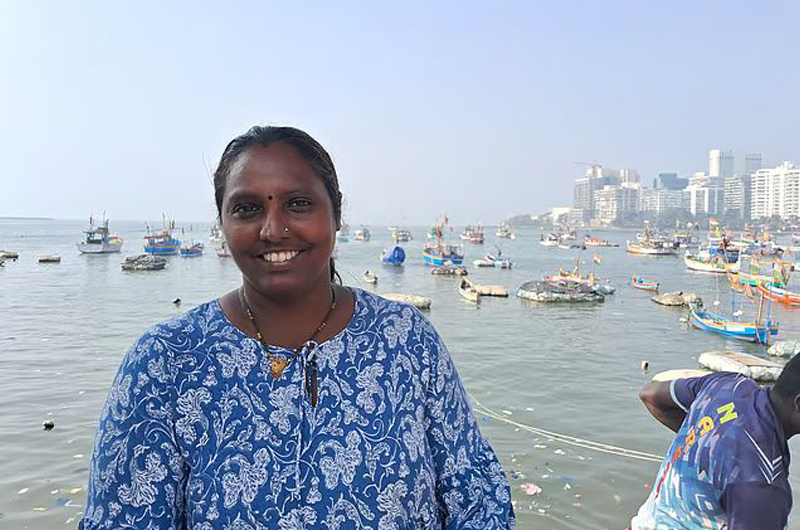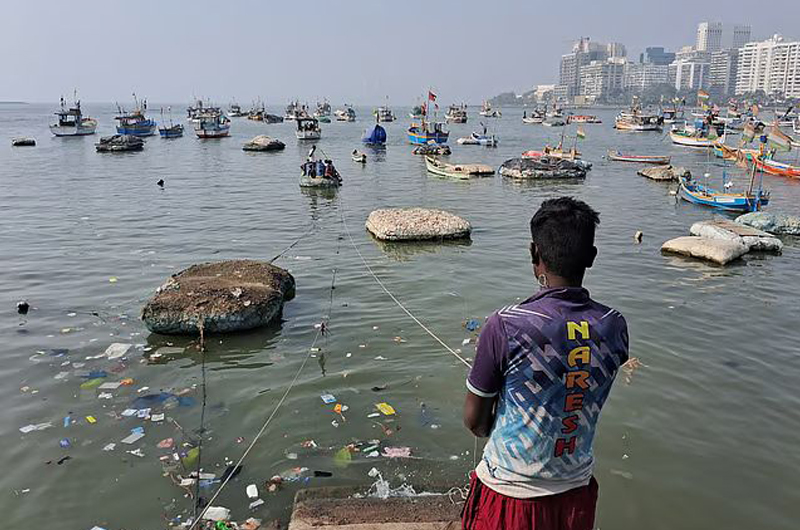Mumbai’s original fishing community, the Kolis, have sustained the city’s coastline for centuries. But as urban expansion and corporate fishing encroach on their waters, their traditions and livelihoods are at risk. Can they reclaim the sea that has always been theirs? Read this article by Sharat Chandra Prasad and Aditi Sajwan to find out
Mumbai’s skyline tells a story of relentless ambition—glass and steel towers stretching skyward, symbols of the city’s rapid urban transformation. Yet, at their feet, tucked between luxury apartments and sprawling construction sites, lie the Koliwadas—fishing villages that predate the city itself. These settlements, home to the Koli Community, are the last remnants of Mumbai’s indigenous maritime culture, clinging to the edge of a city that seems determined to erase them.
Stepping into Machimarnagar, a fishing hamlet in Mumbai’s Cuffe Parade, we were immediately struck by its vibrant energy. The narrow lanes, adorned with murals of fishermen casting their nets and women carrying baskets of fresh catch, told stories of a community deeply tied to the sea. Life revolved around the rhythm of the tides.
In one corner, fishermen sat cross-legged, skillfully weaving nets, each designed for specific fish. “There’s a craft in everything we do,” Ganesh Tandel, a respected fisherman, explained. “A net is not just a tool—it decides what we catch and what we leave behind. If we find an endangered species, we release it back into the sea.” This careful, sustainable approach stood in stark contrast to the industrial trawlers that ravaged marine life without restraint.
Leela, a fisherwoman, had just returned from the market. She led me into her two-bedroom home, where nine family members lived. “I wake up at 3 am and rush to Sassoon Dock to collect fish from my husband or buy from traders. After cleaning, I sit in the market for four hours selling. By 9 am, I’m home, making breakfast, sending my kids to school, and then I start my household work.” She earns just Rs 700 a day—barely enough to feed her family.

The vanishing sea
Ganesh took me to the dockyard, where his boat was moored. He described the challenges of modern fishing: “A short trip lasts 6–7 hours, but a longer one keeps us at sea for days. Yet, fish are harder to find. It’s not just climate change—corporate-owned vessels and illegal fishing by big companies are destroying the marine ecosystem.” He pointed toward the horizon, where massive construction projects loomed. “Even powerful politicians own boats that violate fishing laws. These big players don’t allow fish to breed. How can we sustain ourselves when they don’t leave anything behind for us?”
Mumbai’s rapid urbanisation has pushed the Kolis to the margins. The Coastal Regulation Zone (CRZ) laws meant to protect the coastline are selectively enforced—small fisherfolk are restricted, but large-scale developers proceed unchecked. Real estate projects, like the Mumbai Trans-Harbour Link, further disrupt marine ecosystems, shrinking traditional fishing grounds.

debris—contrasting sharply with the vast, endless ocean behind him.
Burden of plastic waste
Mumbai’s indigenous Koli Community, known for its deep-rooted fishing traditions, is facing mounting challenges—not just from environmental threats but also from a steady decline in fishing families. According to Kailash Tandel, a PhD scholar from the community, Mumbai has 30 fishing villages, but the number of fishing families fell from 10,082 in 2005 to 9,304 in 2010.
Traditionally, Koli men head out to sea while women handle the cleaning, sorting, drying, and selling of fish. However, fishing trips, particularly during high tides and the monsoon, bring an added burden—large amounts of plastic waste tangled in their nets. On such days, even the men must separate plastic from their catch. The problem is worsened by the difficulty of transporting plastic waste back to shore, often leaving fishers with no option but to discard it back into the ocean, fueling an endless cycle of pollution.

A market without support
The hardships don’t end at sea. The fish markets where women like Leela and her neighbour Sunita sell their catch are poorly maintained. “I earn just Rs 500-600 for eight-nine hours of work. There’s no washroom, no proper space to stand,” Sunita lamented. These women are the backbone of Mumbai’s seafood supply, yet they work in degrading conditions. The rise of online grocery stores has also hurt sales. “People hardly come in the mornings anymore,” Leela said. “And Sassoon Dock has no basic facilities—no bathrooms, no drinking water. How are we supposed to work like this?”
The Kolis are also battling an existential crisis. Kailash Tandel, a community leader, spoke passionately about their fight for identity. “Many outsiders write about us like we belong either to land or sea. But we embody both. Our knowledge has sustained marine life for generations, yet we are being sidelined by a system that prioritises profit over people.” The government’s proposed ‘smart fishing villages’ drew sharp criticism. “What does that even mean?” Kailash scoffed. “Are they saying we aren’t smart? That our traditional knowledge isn’t valuable? Moving us into multistory buildings won’t solve anything.”

As I walked along the dockyard, I heard children singing an old Koli song: hey mi haye kola, sorilya doli na Mumbaicha kinari (I am a Koli, born on the shores of Mumbai). Their voices carried both nostalgia and defiance. The Kolis are not just fighting for survival; they are fighting to keep their culture alive. “Our boats can’t sail on roads or tunnels,” a fisherman told me. “If we are separated from the sea, there will be no return.”
The Kolis don’t oppose development—they just want it to be inclusive and sustainable. Mumbai was built on their backs, yet their voices are drowned out in the city’s race for progress. Their fight is not just for their livelihood; it’s for their dignity, their identity, and the sea that defines them.
(Courtesy: India Water Portal/ indiawaterportal.org)



 from Webdoux
from Webdoux